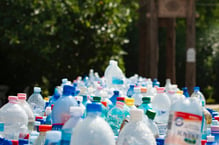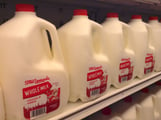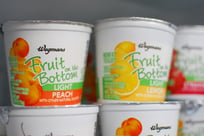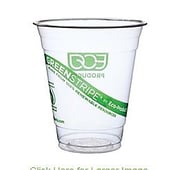Chasing arrows does not always mean recycle-ability
When tossing something out, many of us are in the habit of looking for the chasing arrows or “recycling symbol” at the bottom which contains a number. This is a great practice, but not all the numbers mean the same thing or can be recycled in the same way. The recycling numbers are shorthand for different types of plastic and refer to the chemical makeup of each type of plastic. Different plastics are created from different chemicals and processes, and the type of plastic used to package a product depends on its function, for example, if the plastic should be rigid and sturdy or flexible and stretchy, and whether it needs to be food safe or non-reactive to the chemicals in the product it stores. Some plastics are easier or more profitable to recycle, and some items with the chasing arrows symbol are rarely recyclable curbside, if at all! For example, a styrofoam cup is a #6 plastic and plastic bags are #2 or #4, but both of these items must be handled by specific, less abundant recycling plants, and are not accepted at many commercial recycling plants.
So if the chasing arrows symbol is not always a safe bet or a catchall, the most important thing you can do is to educate yourself about what can be recycled where, and knowing the shorthand for recycling numbers is a great place to start! According to the 2018 State of Recycling in Colorado report “In 2018, we created a record 9,307,000 tons of waste while our recycling rate flat-lined at just 12%, which puts us far behind the national average of 35% recycling.” Understanding which items are recyclable is a good start to raising our waste diversion rate. Check out the Eagle County Waste Wizard App to learn more about what is recyclable in your area, by your hauler, or at your local drop site in Eagle County.
 #1: PET (Polyethylene Terephthalate)
#1: PET (Polyethylene Terephthalate)
Ex: single-use water and soda bottles, cleaning agent bottles, peanut butter, and some food containers.
Polyethylene Terephthalate (PET #1) plastic is one of the most common plastic types, and though they can be recycled at almost any recycling facility, PET can usually only go through the recycling process once or twice before the material breaks down and must be used for non-recyclable materials like insulation or fleece. Plastic products made of PET #1 should only be used once before recycling due to a tendency to leach toxic chemicals over time. If you’re looking to limit your plastic use, #1 plastics are a great place to start by using reusable bottles and containers!
 #2: HDPE (High-density Polyethylene)
#2: HDPE (High-density Polyethylene)
Ex: Milk and water jugs, laundry detergent containers, shampoo, and conditioner bottles, some plastic bags
Number 2 plastic (HDPE) is stable and sturdy and can withstand temperature changes. Clear HDPE, like plastic milk jugs, can be easily recycled into new jugs, while colored HDPE can be remade into outdoor furnishings and toys. Most can be recycled curbside or at a drop site, unless they contain harsh chemical substances like motor oil, coolant, or drain cleaner, in which case they’ll need to be taken to a Household Hazardous Waste facility to be recycled.
 #3: PVC (Polyvinyl Chloride)
#3: PVC (Polyvinyl Chloride)
Ex: clear food packaging, cling wrap, detergent and cleaning spray bottles, some plastic squeeze bottles, cooking oil and food jars**, PVC pipes, shower curtains, flooring, siding, plastic building material
PVC is most recognizable as the material used for plastic pipes, but it is actually most commonly a soft plastic used for packaging. This type of plastic is difficult to recycle due to its chemical structure, and it can release harmful chemicals such as Lead, DEHA (di(2ethylhexyl)adipate), Dioxins, Ethylene dichloride, and Vinyl chloride during production, recycling, and breakdown. There is also evidence that the release of these toxins into the environment from PVC can be absorbed by livestock we rely on for food. For these reasons, consider avoiding #3 PVC plastic and replacing those items with more durable, recyclable, or re-purposed materials.
 #4: LDPE (Low-density Polyethylene)
#4: LDPE (Low-density Polyethylene)
Ex: grocery bags, bread and food bags, plastic wrap, some bottles
LDPE plastic is most commonly used as plastic shopping bags, and other common food packaging you might see at the grocery store. These plastic bags can often be bundled together and brought to big box store for recycling, but they are almost NEVER recyclable in a comingle or curbside stream. This is because the thin plastic easily jams and obstructs the machinery at recycling facilities, making plastic bags the #1 contaminant in most commercial recycling plants. Luckily, plastic bags are some of the easiest plastics to avoid, simply by bringing your own reusable shopping bags, and this is the reason places like Eagle County have taken the lead to ban plastic bags at the municipality level in both Avon and Vail.
 #5: PP (Polypropylene)
#5: PP (Polypropylene)
Ex: yogurt, margarine, soup tubs, disposable diapers, outdoor carpet, clouded plastic containers like baby bottles and straws
Polypropylene is a sturdy, water resistant plastic that is often used to package food and create a moisture barrier. Unfortunately, PP is not easily recycled due to differences in type and grade of plastic, but since it is not as prone to chemical leaching like #1 or #3 plastics, #5 tubs and containers can be reused as storage or tupperware, for example.
 #6: PS (Polystyrene)
#6: PS (Polystyrene)
Ex: “Rigid polystyrene:” CD cases and disposable utensils, and “Formed polystyrene:” styrofoam packaging, cups, and plates, insulation
Polystyrene plastics encompass both clear, rigid plastics used for plastic utensils, as well as that recycling nightmare: styrofoam. While these plastics technically can be recycled, they are often not profitable as recycled materials, so many recycling facilities will not accept them, including Eagle County. Plastic utensils are easily avoided by carrying your own set of cutlery. You don’t even need to go out and buy expensive sets of matching bamboo utensils, simply throw that extra fork, spoon, and knife that doesn’t match your kitchen set into your backpack or purse on the go! To avoid styrofoam, check the packaging materials before you order items online, and refuse styrofoam cups and plates at events.

#7: (Other)
Ex: Bioplastic*, lids, electronics, plastic baby bottles, reusable water bottles, some clear plastic cutlery
The seventh type of plastic is a catchall for all other plastic types not easily sorted in #1-6. Compostable plastics made of biodegradable materials also fall under #7 plastics, even though they are not even really “plastic” in the typical sense. These materials will often carry a “BPI Certified” Logo or have the term “compostable” written on the product itself. Some bioplastics will also say they are #0 plastic, and these are commercially compostable as well. These bioplastics are made from plant-based polymers like corn and other biomass substances and can be broken down by the high temperatures reached at commercial compost facilities like the new Vail HoneyWagon commercial composting facility in Wolcott, CO (note, because of their size only compostable silverware is accepted locally, not #7 plastic compostable cups).
Looking at the examples of each type of plastic, it probably becomes clear that not every type of plastic is easily recycled, and not everything under one number recycles equally. We need to realize we can’t jump to the conclusion that an item is recyclable just because it carries a certain number. For example, a #3 spray bottle would be accepted by many recycling facilities while a #3 shower curtain or cling wrap most often would not. It is also important to note that while recycling is an important step, most plastics can only be recycled once or twice before the product degrades too much to be reused, and this is even true of #1 plastics, which are often thought of as the most easily recycled. Many #7 plastics also have little to no market recycling value, and in Eagle County sometimes must spend money to recycle these plastics rather than selling the products for money. That’s why the three R’s—reduce, reuse, and recycle—are best practiced in that order! Refusing or reducing our plastic use on a community-level scale is a first step to reaching a more sustainable plastic-free future. Read our article about changing recycling market values to learn more.
SOURCES:
https://www-tc.pbs.org/strangedays/pdf/StrangeDaysSmartPlasticsGuide.pdf
https://learn.eartheasy.com/articles/plastics-by-the-numbers/
https://docs.google.com/document/d/1XvUTe3KZjSRdvJ9MiQ-CXKl7cmDYDLwkLrRh4mtApvw/edit







